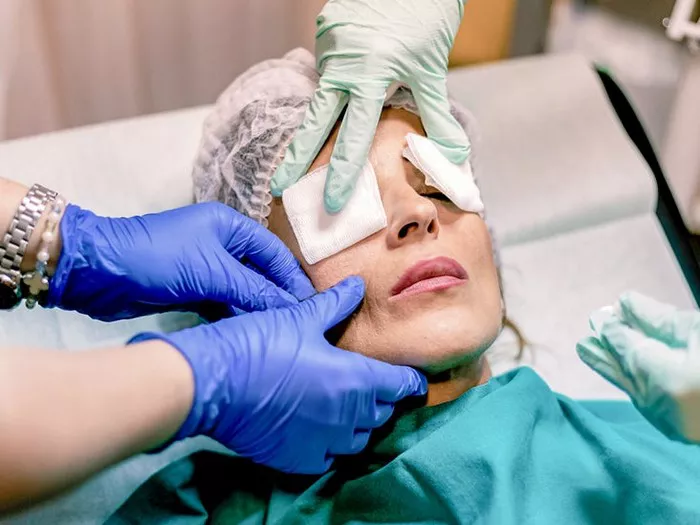Eyelid surgery, also known as blepharoplasty, is a common cosmetic procedure that aims to rejuvenate the appearance of the eyes by addressing sagging eyelids, excess skin, and under-eye bags. Like any surgical procedure, eyelid surgery involves incisions, which can result in scars. If you’re considering eyelid surgery, it’s important to understand the healing process and the timeline for scar maturation. In this article, we will explore how long it takes for scars to heal after eyelid surgery and provide insights into the factors that influence the healing process.
Understanding Eyelid Surgery Scars
During eyelid surgery, the surgeon makes incisions along the natural creases of the eyelids to minimize their visibility. The location and length of the incisions may vary depending on the specific concerns being addressed. Although surgeons take great care to make the incisions as inconspicuous as possible, scars are an inevitable part of the healing process.
Eyelid surgery scars tend to be well-concealed within the natural contours of the eyelids. Over time, they typically fade and become less noticeable, blending with the surrounding skin. However, it’s important to note that individual healing patterns can vary, and some factors can affect the visibility and maturation of scars.
Timeline for Scar Healing
The timeline for scar healing after eyelid surgery can vary from person to person. Generally, scars go through several stages as they heal:
-
Initial Healing (1-2 weeks)
In the first one to two weeks following eyelid surgery, the incision sites will be in the early stages of healing. During this time, it is common to experience some swelling, bruising, and mild discomfort. The surgeon may provide instructions on how to care for the incisions, including keeping them clean and applying topical ointments or prescribed medications.
-
Early Scar Formation (2-6 weeks)
As the incisions continue to heal, a scar will begin to form. Initially, the scar may appear red or pink and may feel raised or slightly bumpy. It’s important to follow the post-operative care instructions provided by the surgeon to promote proper healing during this stage.
-
Maturation and Fading (6 weeks – 1 year)
Over the following months, the scar will continue to mature and fade. The redness and swelling should gradually diminish, and the scar may become lighter in color, closer to the surrounding skin tone. It’s important to protect the incision sites from sun exposure during this time, as sunburn can delay the healing process and cause the scars to darken.
-
Final Scar Appearance (1 year or longer)
After approximately one year, the scars should have reached their final appearance. They may appear pale, flat, and blend well with the surrounding skin. While the scars may still be visible upon close inspection, they should be significantly less noticeable compared to the initial healing stages.
Factors Influencing Scar Healing
Several factors can influence the healing process and the final appearance of scars after eyelid surgery:
- Individual Healing Factors: Each person’s body has a unique healing process. Factors such as genetics, age, overall health, and skin type can impact how scars form and fade.
- Proper Wound Care: Following the surgeon’s post-operative instructions and taking proper care of the incision sites can promote optimal healing. This includes keeping the incisions clean, avoiding strenuous activities that can strain the eyelids, and applying any recommended ointments or medications.
- Sun Exposure: Protecting the incisions from direct sunlight is crucial during the healing process. UV rays can cause scars to darken and become more pronounced. It is recommended to wear sunscreen and sunglasses when going outdoors and to avoid tanning beds or prolonged sun exposure.
- Smoking and Alcohol Consumption: Smoking and excessive alcohol consumption can impair the body’s healing process and delay scar maturation. It is advisable to refrain from smoking and limit alcohol intake both before and after eyelid surgery.
- Post-operative Complications: In rare cases, complications such as infection or poor wound healing can affect scar formation and maturation. It is essential to promptly report any concerns or unusual symptoms to the surgeon for evaluation and appropriate management.
Managing Scars After Eyelid Surgery
While complete scar elimination is not possible, there are steps you can take to promote optimal scar healing after eyelid surgery:
- Follow Post-operative Care Instructions: Adhere to the post-operative care instructions provided by your surgeon. This includes cleaning the incisions, applying recommended ointments or creams, and attending follow-up appointments.
- Protect the Incisions from Sun Exposure: Shield the incisions from direct sunlight by wearing sunglasses, using a broad-spectrum sunscreen, and avoiding tanning beds. Sunburn can lead to hyperpigmentation and make scars more visible.
- Massage the Scars: Once the incisions have healed, your surgeon may recommend gently massaging the scars to help soften them and promote better scar maturation.
- Consider Scar-Reducing Products: Certain topical creams, gels, or silicone sheets may help minimize the appearance of scars. Consult with your surgeon for recommendations on scar-reducing products that are suitable for use on the delicate skin around the eyes.
Conclusion
The healing process and timeline for scar maturation after eyelid surgery can vary from person to person. While scars are an inevitable outcome of any surgical procedure, they tend to fade and become less noticeable over time. By following proper post-operative care instructions, protecting the incisions from sun exposure, and maintaining a healthy lifestyle, you can optimize the healing process and promote the best possible outcome for your eyelid surgery scars. Remember to consult with your surgeon for personalized advice and guidance throughout the healing journey.


